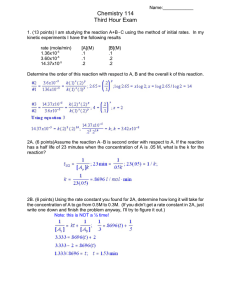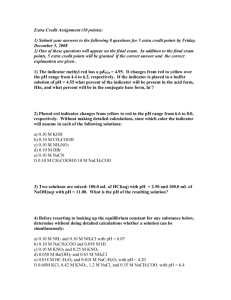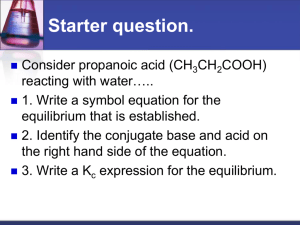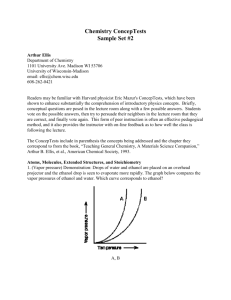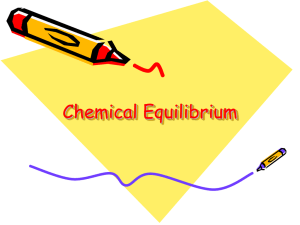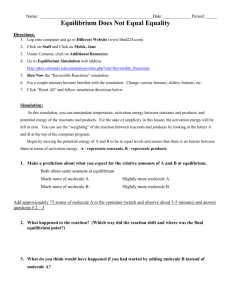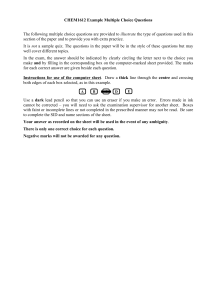chemistry pretest - the Biology Scholars Program Wiki
advertisement
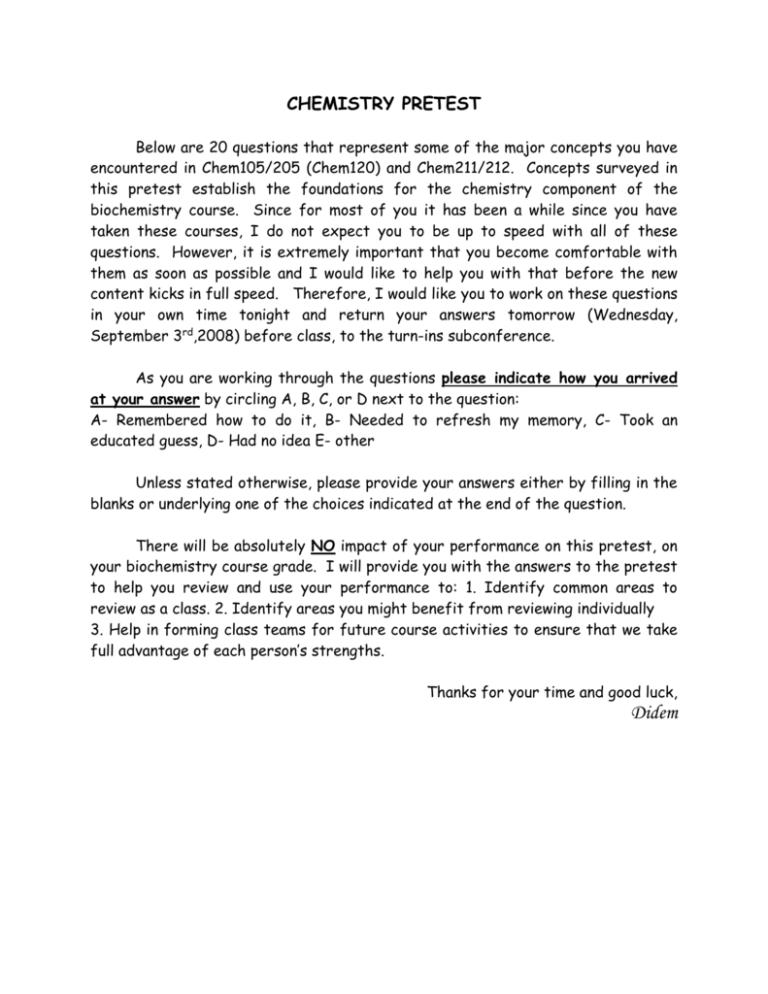
CHEMISTRY PRETEST Below are 20 questions that represent some of the major concepts you have encountered in Chem105/205 (Chem120) and Chem211/212. Concepts surveyed in this pretest establish the foundations for the chemistry component of the biochemistry course. Since for most of you it has been a while since you have taken these courses, I do not expect you to be up to speed with all of these questions. However, it is extremely important that you become comfortable with them as soon as possible and I would like to help you with that before the new content kicks in full speed. Therefore, I would like you to work on these questions in your own time tonight and return your answers tomorrow (Wednesday, September 3rd,2008) before class, to the turn-ins subconference. As you are working through the questions please indicate how you arrived at your answer by circling A, B, C, or D next to the question: A- Remembered how to do it, B- Needed to refresh my memory, C- Took an educated guess, D- Had no idea E- other Unless stated otherwise, please provide your answers either by filling in the blanks or underlying one of the choices indicated at the end of the question. There will be absolutely NO impact of your performance on this pretest, on your biochemistry course grade. I will provide you with the answers to the pretest to help you review and use your performance to: 1. Identify common areas to review as a class. 2. Identify areas you might benefit from reviewing individually 3. Help in forming class teams for future course activities to ensure that we take full advantage of each person’s strengths. Thanks for your time and good luck, Didem A. B. C. D. Q1. Match the atoms and molecules listed on the left with ALL the appropriate descriptive(s) on the right. (Multiple descriptives may apply to one molecule) a. Cl___ cation b. H2O ___ anion + c. Na ___ polar d. CH4 ___ uncharged ___ nonpolar A. B. C. D. Q2. A single water molecule can participate in up to ___ hydrogen bonds. (One, Two, Three, Four, Five) Q3. A. B. C. D. a. A solution with pH = 5 contains 100 times more H+ than a solution with a pH of _____ ? (7, 3, 0.05) A. B. C. D. b. The pH of 90 mL of a 0.1 M solution of HCl is measured with a digital pH meter and shown to be about 1. Roughly _____ mLs of water need to be added to reach a pH of about 2? (10, 100, 1000) A. B. C. D. c. A beaker contains 100 mL of salt water. If 100 mL of distilled water is added to the beaker: i. the number of moles of NaCl: (increases by 50%, decreases by 50%, doesn't change) ii. the concentration of NaCl (increases by 50%, decreases by 50%, doesn't change) A. B. C. D. Q4. In the following reaction for the forward reaction, which species is acting as an acid? _______ Q5. For the reaction, CH3COOH CH3COO- + H+, pKa = 5. A. B. C. D. a. At pH = 5, what is the most prevalent species? (CH3COOH, CH3COO-, equal amounts of the acid and its conjugate base) A. B. C. D. b. At pH = 2, what is the most prevalent species? (CH3COOH, CH3COO-, equal amounts of the acid and its conjugate base) 1 A. B. C. D. c. The plot below shows the concentration of CH3COOH and CH3COOas a function of pH. Which plot corresponds to the concentration of acetic acid, CH3COOH, as a function of pH? ___ A. B. C. D. Q6. Which acid has the lowest pKa? ____ A. B. C. D. A. B. C. D. Q7. Q. Which is the most acidic carbonyl compound? ______ A. B. C. D. A. B. C. D. Q8. Which of the following can act as a nucleophile in metabolic reactions? _____ I. Nitrogen of amino group II. Oxygen of a hydroxyl group III. Carbon of a carbonyl group a. I only b.II only c. III only d. I and II only e. I, II, and III 2 A. B. C. D. Q9. Cortisone (shown on the right) contains which functional groups? _____ A. Ether, alkene, alcohol B. Alcohol, ketone, amine C. Alcohol, ketone, alkene D. Ether, amine, ketone A. B. C. D. Q10. One of the two equivalent energy resonance structures for formate anion is shown below. Which carbon-oxygen bond is longer? (A, B, Both are equal) A. B. C. D. Q11. On the right is the structure of the liquid crystal. a. How many hydrogen atoms are present in the structure? ____ (13, 17, 21) b. How many carbon atoms are present in the structure? ____ (13, 18, 21) c. Which part of the molecule is more rigid? ______(left box, right box) A. B. C. D. Q12. a. How many stereogenic carbon atoms are present in the molecule pictured below? _____ (3, 4, 5) b. What is the R and S configuration for each stereogenic center in this sugar, from top to bottom? _____ i. R,R, S ii. R,S, S iii. R,S, R c. Is this a D or L sugar? ______ A. B. C. D. Q13. Which is the more stable chair configuration of trans-1-chloro3-methylcyclohexane? ______ A. B. 3 A. B. C. D. Q14. Please indicate whether the following pairs represent resonance forms (R) or structures which are in equilibrium (tautomers) (T). A. B. C. D. Q15. For the reaction: 2NO2(g) 2NO(g) + O2(g) each of the following curves corresponds to one of the species (reactants or products) in the reaction given above. Which curve represents the time dependence of the concentration of O2? ______. A. B. C. D. Q16. Which of the following is true about the change in enthalpy (H) of a reaction that is spontaneous at room temperature? ______ a. It is equal to TS b. It is positive and the reaction is exothermic c. It is negative and the reaction is endothermic d. It must be equal to zero e. It can be either positive or negative A. B. C. D. Q17. Which equation defines a system (a process or reaction) at equilibrium? ___ a. ∆G>0 b. ∆Go’ = ∆G c. ∆G = 0 d. ∆Go’ = 0 e. ∆G = RTlnQ A. B. C. D. Q18. Given: heat + N2O4 <= >2 NO2 What happens to the equilibrium constant, Keq as temperature increases? (increases, decreases, remains constant) 4 A. B. C. D. Q19 . For the reaction: Based on the concentration-time graph graph given, what is the value of the equilibrium constant? ____ (1, 2, 4) A. B. C. D. Q20. Given the chemical equilibrium N2(g) + 3H2(g) <=> 2 NH3(g) + reaction energy a. Which are collectively stronger bonds? (those in the reactants, those in the products) b. What effect will spraying H2O into the system have if NH3 is far more soluble in H2O than N2 and H2? (no effect, increase product, increase reactants) 5
